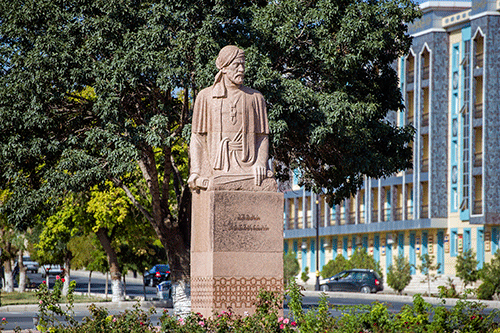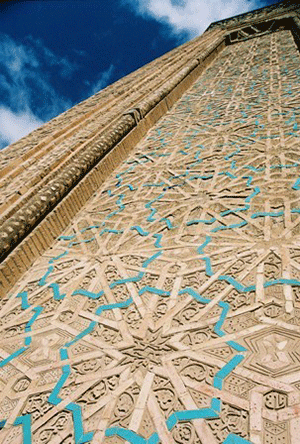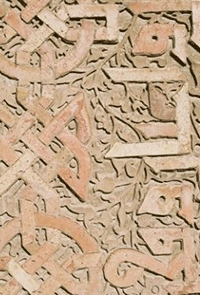Archıtecture

Nakhchivan has widely been known with its unique architectural monuments in Middle East since long. From the dwelling places, concerning to the end of the III millennium and to the beginning of the II millennium, were found building remainders being built of art-brick, mighty castle walls, early city places, being surrounded with rectangle and semicircular towers in the territory of Nakhchivan (I and II Kultapa, Govurgala, Garabaglar, Oglangala, Plovtapa, Gazanchi, Vaykhir, Chalkhangala, etc.). These monuments shed a light on relations of Azerbaijan, as well as Nakhchivan, with the highly developed cultural centers of the Middle East. Dwelling places of Nakhchivan concerning to different historical periods, Cyclopian buildings, castles, fortifications, material, cultural and architectural monuments, building materials, building technology, etc. arrest our attention by their richness.
In the XII century Nakhchivan, being the capital of the mighty Atabeys State, was one of the political, economical and handicraft centers of Azerbaijan. The mastery of architecture reached its high level here; there were built a lot of religious-architectural monuments and civic buildings: sublime mosques decorated with ornaments and colors, tombs, palaces, caravansaries, bridges, castles and towers, religious schools for Muslims, decorated living houses, richly designed bath-houses, etc.The architects from Nakhchivan - Ajami ibn Abubakr and Ahmad ibn Ayyub had great services in creating of tower-shaped tombs, being mostly spread type of memorial architecture of the Middle Ages in Azerbaijan. Yusif ibn Kuseyr's tomb and Momina Khatun's tomb, which had been raised by architect Ajami in the second half of the XII century, and which reached our time safely, are the most successful samples of eternalizing of a man's memory with monumental cuts. Being one of the highest and most delicate tombs not only in Azerbaijan, but in the Islam countries as well, such longevity of Momina Khatun tomb most of all is connected with the completeness of the engineer's solution. In his masterpiece the architect Ajami showed not only the depth of artistic thinking and the tenderness of taste, but also an engineering brilliance based on large mathematical knowledge and rich experience. The perfect bearing system of the monument, especially the tectonic structure of the tomb, clearly shows that the architect from Nakhchivan didn't in vain carry the name of "the sheikh of engineers" even during his lifetime. As a result of Ajami's activity, the Nakhchivan architecture school was established and formed in the history of Azerbaijan architecture.

School of architecture in Nakhchivan was guided by the mathematical calculation methods. The monuments were constructed according to precise calculation and measures, plans, location, and accurate arrangement of the ornaments and inscriptions. With the influence of this school a lot of architectural compositions were created in the countries of Middle East. The architecture of Nakhchivan is not only popular with stone architectural monuments, but with the monuments of main building materials of which were red burned and violet colored bricks (Imamzadah architectural complex, etc). Losing its former grandeur as the result of Mongol aggression, reviving as other cities of Azerbaijan in the period of the Elkhani rulers in the second half of the XIV century, facing execution-robbery events during the marches of the Khan of the Golden Horde Tokhtamish and Emir Teymuor, passing from hands to hands more than once in the XVI century, and undergoing danger of destruction twice in the first half of the XVII century, Nakhcivan had lost its former grandeur, leading role and position in the political-economic and cultural life of Azerbaijan. Military-political events caused great detriment to the cultural centers as Julfa, Ordubad and Aylis. Hundreds of valuable buildings and monuments, having been created by notable architects, had been fallen to the ground, not reaching our times. Very often even the names of skillful craftsmen and people’s masters were not known.
Since the second half of the XVII century a definite reviving was felt in the lives of Nakhchivan, Ordubad and Julfa cities. According to the information of Turkish historian Ovliya Chalabi, there were 20 thousand houses, 70 religious buildings, 20 caravansaries, 7 bathhouses and markets in Nakhchivan in the XVII century. Besides, Imamzadah architectural complex (XVI-XVII centuries), Ismayil Khan’s bathhouse (XVIII-XIX centuries), Khan’s house (XIX century), mosques and religious schools for Muslims, force houses, bathhouses and caravansaries, the ensemble of Arassat square, and the complex of covered market in Ordubad were built. Tombs and mosques, other architectural monuments, historical buildings were built in the villages Dar, Dasta, Aylis, Dimis, Ganza, Vanand. Architectural monuments, concerning to the XVIII century, the walls of which were decorated with beautiful pictures, have been reached our time.

None the less, Armenian “researchers”, trying always to falsify the history in the sake of ideology, utilized skillfully the political and ideological atmosphere of the Soviet period. They put forward territorial claims against Nakhchivan land carrying out “scientific” blackmail campaigns as part of offensive “Great Armenia” plan and still the propaganda is on the agenda. In contrast to scientific facts and methodology, they buried grave stones by wrong ways in the territory of Nakhchivan, which is full up with ancient Azerbaijan monuments, then beginning to make a racket put ahead the territorial claim to our lands. Coming to the territory of Nakhchivan by illegal ways, Armenian historians took photo-pictures of historical monuments, concerning to different periods, made some changes on them, published books full of pictures and articles overcrowded with fib information. Nevertheless, politicized armenian “researchers” could not be succeeded on destruction of the Azerbaijani monuments in Nakhchivan, and their concocted claims were completely disproved by genuine scholars.
Currently, in Nakhchivan Autonomous Republic a lot of important state decisions had been accepted in the fields of research, protection and restoration of national and spiritual knowledge, and monuments having great historical value, and complex measures had been carried out for their protection and preservation.
The Decrees of the Chairman of the Supreme Majlis of Nakhchivan Autonomous Republic “On organization of the protection and passport registration of historical and cultural monuments in the territory of Nakhchivan Autonomous Republic”, “On the restoration of the prophet Noah’s grave tomb in Nakhchivan”, “On the establishment of the “Khan Palace” State Historical-Architectural Museum”, “On the establishment of Nakhchivan Center”, the establishment of Ordubad “Gamigaya Historical-Artistic Reserve” and Sharur “Arpachay Historical-Cultural Reserve” have significantly contributed to the study and promotion of our historical monuments and cultural heritage.
Consistent measures are being implemented to explore our monuments and propagandize our culture internationally. The International symposiums “Nakhchivan in International Resources” in 1996, “Prophet Noah, World Storm and Nakhchivan” in 2009, “Nakhchivan: as the primary settlement and urban building” in 2011, “Nakhchivan: the primary city and Duzdagh” in 2012 were of great importance in the study of the urban culture of Nakhchivan, which is five thousand years old. More than 1,200 monuments were registered and certificated in the autonomous republic in 2006-2012. About 550 of these monuments are of world and country importance, while others are of local importance. “Nakhchivan Monuments” Encyclopedia was prepared on the basis of registered monuments. This encyclopedia is an important source for studying and promoting our ancient monuments internationally.


